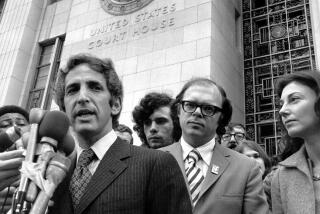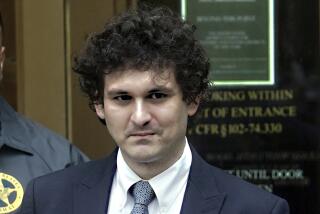‘Crunching’ the Numbers Key to Brady Mission
- Share via
As the presidential commission studying the causes of the October stock market crash began its task, the panel and staff knew that the credibility of the final report would depend heavily on a solid statistical foundation for its conclusions and recommendations.
But the two months allotted for the job by the White House seemed far too little time to uncover definitive patterns among the millions of trades that buried the nation’s markets on Oct. 19 and the surrounding days.
“It was clear from the start, in the minds of the task force, that we had to have the numbers,” said James F. Gammill, a Harvard Business School professor on the commission’s staff. “But there was a tremendous amount of transactions, miles of computer tapes.”
It was Gammill’s knowledge of work under way by one of his former professors that led the so-called Brady Commission to one of the most potent weapons in its arsenal--a team of four “numbers crunchers,” led by two finance professors at UC Berkeley.
These four men, later aided by two computer experts from IBM, discovered how key classes of traders--some major brokerage firms, mutual funds and portfolio insurers--dominated the massive stock selloff that drove the market down 508 points on Oct. 19.
While the finding supported earlier published accounts of the causes of the crash, the extensive quantitative detail provided a unique view of the inner workings of the stock markets and the role played by big institutions and computerized trading.
But the story of these mathematical “James Bonds” is part of the broader story of how an ad hoc team of volunteers from academia and Wall Street compiled a harrowing account of the financial system’s collapse in a remarkably short time.
It is a story set in the fortress-like Federal Reserve Bank in the Wall Street financial district, where the 44 staff members were jammed into two rooms on the 11th floor; a story of cooperation despite nerves frayed by 20-hour days and deadline pressures.
Most important, it is a story of the men and women who transformed hundreds of interviews and millions of trades into a thick blue volume, ponderously titled “Report of the Presidential Task Force on Market Mechanisms,” that they hope will kindle a national debate on the future of the financial system.
The story started Oct. 23 when President Reagan said he would appoint Nicholas F. Brady, a New York investment banker and former U.S. senator, to head a commission to investigate the how and why of the market collapse.
Within days, Brady began building a staff. One of the first to join was Robert Glauber, a professor at Harvard Business School. He was named executive director and added three Harvard colleagues to the staff.
Nagging Problem
Others were brought in from Wall Street--experts on trading and the futures market--to add vital skills and deflect potential criticism.
“We knew we’d be open to a hell of a blast if Wall Street wasn’t well represented,” said one early staff member, who asked that his name not be used.
By the time Reagan issued his formal executive order creating the commission on Nov. 5, the work had begun in the cramped quarters at the Federal Reserve. The effort was divided into eight separate studies, and staffers were assigned to various tasks within those studies.
But the “numbers” remained a nagging problem and it was not until after the work had begun that Gammill suggested contacting Terry A. Marsh, a finance professor at the University of California, Berkeley.
Marsh, one of Gammill’s professors at MIT a few years earlier, is an expert in analyzing market events. He had been working on a stock analysis project with a UC associate, Albert S. Kyle, and with Robert A. Wood of Pennsylvania State University, and Gilbert Beebower of SEI Corp., an investment research organization.
At first, Marsh and Kyle were sounded out about ideas for working up useful numbers. Eventually, Gammill said, all four were asked to join the commission staff.
After the report was issued on Jan. 8, Robert G. Kirby, a Los Angeles money manager and one of four commission members appointed by Reagan to join Brady, said the complex task of discovering the causes of the collapse had required “James Bond.”
Wood agreed, to a point, saying in an interview: “It definitely had an element of James Bond. But I don’t think we were after crooks. What we were trying to do was just be able to read the footprints in the trading.”
Marsh put it another way, saying: “We were painting a picture of what was really going on, looking more for classes of traders than individuals or particular institutions.”
While their earlier work meant that they were familiar with trading data, the group members were staggered by the amount of material they had to analyze. More than 200 tapes containing individual trades had been supplied to the commission through the Securities and Exchange Commission with the cooperation of the various exchanges around the country.
“If you started out cold, you could spend a few months before you figure out what the footprints and patterns were,” Marsh said.
However, the time was drastically cut because the trading experts from the Wall Street firms taught the numbers crunchers how to pick out clues to identify computerized program trading and other institutional buying and selling. Marsh refused to discuss the clues, but acknowledged that they were enormously helpful.
Marsh and the others were eventually joined by two experts on loan from IBM, Kathleen Adams and George Jang.
Two types of sophisticated, computerized trading techniques--program trading and portfolio insurance--had been suspected of creating downward pressure on the market with massive selling on Oct. 19. Program trading covers a variety of trading techniques to buy and sell huge blocks of stock instantaneously on the basis of tiny price fluctuations. Portfolio insurance is a strategy used to sell stock or futures contracts to try to minimize losses during a market decline.
As data began to emerge pointing to the two techniques as culprits in the crash, it was shared with other groups within the staff and helped sharpen the focus of the entire effort.
“There was a lot of cross-checking,” Marsh said.
Patterns began emerging around Thanksgiving and several staff members said the data analysis became particularly helpful in the informal interviews conducted with hundreds of traders and representatives of big financial institutions.
“Clearly, the whole nature of the interviewing changed because we had the data right in front of us when we were questioning people,” said one staff member, who asked that his name be withheld. “It makes it a lot harder to lie.”
Actual questioning of most people occurred in a conference room on the 10th floor of the Fed. The atmosphere was informal and, in the words of one interviewer, “more like an education than an interrogation.”
There were rumors that some firms refused to cooperate with the inquiry, but no one was ever identified as having withheld information.
A key provision in securing cooperation was a promise that information would remain confidential and that the final report would not contain the names of individuals or firms. Since the commission lacked subpoena power, members felt that such a promise was essential.
But confidential information did not always remain that way. There were several leaks to newspapers. The staff was particularly upset when the Washington Post published details of extensive selling by Wells Fargo’s investment unit and the Boston Globe published a story about the selling activities of the Fidelity mutual funds.
“The leaks upset most of us because we are private-sector people and they involved some of our customers,” said B. Thomas Byrne Jr., an options trader with Shearson Lehman Bros. who worked on the staff. “It was certainly not in our interest to have a leak involving a customer.”
No one was put on a lie detector, but information flowed less freely after the leaks. One morning after being quoted by name in a newspaper story, a staff member said he came to work and found a memo on his desk warning against talking to anyone about commission work. The memo was from Joel J. Cohen, the commission’s general counsel.
One thing that has not leaked yet is who decided to term the events of Oct. 19 a “market break,” rather than a crash, as newspapers and others commonly refer to the 508-point drop.
Howard M. Stein, chairman of the Dreyfus Corp. investment firm and a commission member, said he thought the decision was made by Brady and Glauber, the executive director.
He also said “White House sensitivities” probably played a role in picking a term with softer implications. Calls to Glauber and Brady were not returned.
The final report was a group writing effort, compiled from the work of all eight studies and blended into 340 pages. The process became so frantic as the deadline approached that a person operating one of the word processors fainted and required medical attention. But the blue volume came out on time anyway.
More to Read
Get the L.A. Times Politics newsletter
Deeply reported insights into legislation, politics and policy from Sacramento, Washington and beyond. In your inbox three times per week.
You may occasionally receive promotional content from the Los Angeles Times.









